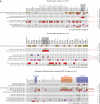Meta-analysis of cancer gene expression signatures reveals new cancer genes, SAGE tags and tumor associated regions of co-regulation
- PMID: 20621981
- PMCID: PMC2978353
- DOI: 10.1093/nar/gkq574
Meta-analysis of cancer gene expression signatures reveals new cancer genes, SAGE tags and tumor associated regions of co-regulation
Abstract
Cancer is among the major causes of human death and its mechanism(s) are not fully understood. We applied a novel meta-analysis approach to multiple sets of merged serial analysis of gene expression and microarray cancer data in order to analyze transcriptome alterations in human cancer. Our methodology, which we denote 'COgnate Gene Expression patterNing in tumours' (COGENT), unmasked numerous genes that were differentially expressed in multiple cancers. COGENT detected well-known tumor-associated (TA) genes such as TP53, EGFR and VEGF, as well as many multi-cancer, but not-yet-tumor-associated genes. In addition, we identified 81 co-regulated regions on the human genome (RIDGEs) by using expression data from all cancers. Some RIDGEs (28%) consist of paralog genes while another subset (30%) are specifically dysregulated in tumors but not in normal tissues. Furthermore, a significant number of RIDGEs are associated with GC-rich regions on the genome. All assembled data is freely available online (www.oncoreveal.org) as a tool implementing COGENT analysis of multi-cancer genes and RIDGEs. These findings engender a deeper understanding of cancer biology by demonstrating the existence of a pool of under-studied multi-cancer genes and by highlighting the cancer-specificity of some TA-RIDGEs.
Figures








Similar articles
-
Differentially expressed genes in pancreatic ductal adenocarcinomas identified through serial analysis of gene expression.Cancer Biol Ther. 2004 Dec;3(12):1254-61. doi: 10.4161/cbt.3.12.1238. Epub 2004 Dec 14. Cancer Biol Ther. 2004. PMID: 15477757
-
Transcriptome annotation using tandem SAGE tags.Nucleic Acids Res. 2007;35(17):e108. doi: 10.1093/nar/gkm495. Epub 2007 Aug 20. Nucleic Acids Res. 2007. PMID: 17709346 Free PMC article.
-
Highly expressed genes in pancreatic ductal adenocarcinomas: a comprehensive characterization and comparison of the transcription profiles obtained from three major technologies.Cancer Res. 2003 Dec 15;63(24):8614-22. Cancer Res. 2003. PMID: 14695172
-
[Transcriptomes for serial analysis of gene expression].J Soc Biol. 2002;196(4):303-7. J Soc Biol. 2002. PMID: 12645300 Review. French.
-
Technology evaluation: SAGE, Genzyme molecular oncology.Curr Opin Mol Ther. 2001 Feb;3(1):85-96. Curr Opin Mol Ther. 2001. PMID: 11249736 Review.
Cited by
-
Cliques for the identification of gene signatures for colorectal cancer across population.BMC Syst Biol. 2012;6 Suppl 3(Suppl 3):S17. doi: 10.1186/1752-0509-6-S3-S17. Epub 2012 Dec 17. BMC Syst Biol. 2012. PMID: 23282040 Free PMC article.
-
Affymetrix GeneChip microarray preprocessing for multivariate analyses.Brief Bioinform. 2012 Sep;13(5):536-46. doi: 10.1093/bib/bbr072. Epub 2011 Dec 30. Brief Bioinform. 2012. PMID: 22210854 Free PMC article.
-
Replication-dependent histone isoforms: a new source of complexity in chromatin structure and function.Nucleic Acids Res. 2018 Sep 28;46(17):8665-8678. doi: 10.1093/nar/gky768. Nucleic Acids Res. 2018. PMID: 30165676 Free PMC article. Review.
-
A rapid nested polymerase chain reaction method to detect circulating cancer cells in breast cancer patients using multiple marker genes.Oncol Lett. 2014 Jun;7(6):2192-2198. doi: 10.3892/ol.2014.2048. Epub 2014 Apr 8. Oncol Lett. 2014. PMID: 24932314 Free PMC article.
-
Identification of a gene signature for discriminating metastatic from primary melanoma using a molecular interaction network approach.Sci Rep. 2017 Dec 11;7(1):17314. doi: 10.1038/s41598-017-17330-0. Sci Rep. 2017. PMID: 29229936 Free PMC article.
References
-
- Velculescu VE, Zhang L, Vogelstein B, Kinzler KW. Serial analysis of gene expression. Science. 1995;270:484–487. - PubMed
-
- Rhodes DR, Yu J, Shanker K, Deshpande N, Varambally R, Ghosh D, Barrette T, Pandey A, Chinnaiyan AM. Large-scale meta-analysis of cancer microarray data identifies common transcriptional profiles of neoplastic transformation and progression. Proc. Natl Acad. Sci. USA. 2004;101:9309–9314. - PMC - PubMed
-
- Bueno-de-Mesquita JM, van Harten WH, Retel VP, van't Veer LJ, van Dam FS, Karsenberg K, Douma KF, van Tinteren H, Peterse JL, Wesseling J, et al. Use of 70-gene signature to predict prognosis of patients with node-negative breast cancer: a prospective community-based feasibility study (RASTER) Lancet Oncol. 2007;8:1079–1087. - PubMed
Publication types
MeSH terms
Substances
LinkOut - more resources
Full Text Sources
Research Materials
Miscellaneous

